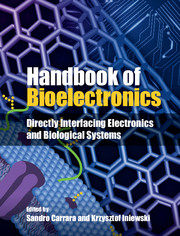Book contents
- Frontmatter
- Contents
- List of Contributors
- 1 What is bioelectronics?
- Part I Electronic components
- Part II Biosensors
- 8 Introduction to biosensors
- 9 CNT and proteins for bioelectronics in personalized medicine
- 10 CMOS nanowire biosensing systems
- 11 Cell-array biosensors
- 12 System-on-a-chip pulse radar for contactless motion sensing in human–machine smart interfaces
- 13 MagCMOS
- 14 Metamorphic neural interfaces with insects for remote controlled biobots
- Part III Fuel cells
- Part IV Biomimetic systems
- Part V Bionics
- Part VI Brain interfaces
- Part VII Lab-on-a-chip
- Part VIII Future perspectives
- Index
- References
8 - Introduction to biosensors
from Part II - Biosensors
Published online by Cambridge University Press: 05 September 2015
- Frontmatter
- Contents
- List of Contributors
- 1 What is bioelectronics?
- Part I Electronic components
- Part II Biosensors
- 8 Introduction to biosensors
- 9 CNT and proteins for bioelectronics in personalized medicine
- 10 CMOS nanowire biosensing systems
- 11 Cell-array biosensors
- 12 System-on-a-chip pulse radar for contactless motion sensing in human–machine smart interfaces
- 13 MagCMOS
- 14 Metamorphic neural interfaces with insects for remote controlled biobots
- Part III Fuel cells
- Part IV Biomimetic systems
- Part V Bionics
- Part VI Brain interfaces
- Part VII Lab-on-a-chip
- Part VIII Future perspectives
- Index
- References
Summary
Rapid development in micro- and nanotechnologies in recent years has createdopportunities for the technology to connect to individual cells, bacteriaand viruses (Figure 8.1). The ability to sense biological properties createsamazing opportunities to improve human lives through advances in earlydisease detection, health monitoring, and new biology-based products. Evenmore exciting is the technology’s ability to sense DNA and proteins.The exploration of bio-organic device functionality and sensing in thefuture will require interfacing to traditional electronic materials andstructures [1,2].
An example of one such interface was recently considered in the context ofthe resonant sensing of biomolecules [3]. Resonant far-infrared (IR)spectroscopy is a common technique for the characterization of biologicalmolecules. The lower portion of the THz spectrum of DNA and proteins is alsobeing actively studied using both experimental and computational methods. Todate, good progress has been made in the detection and identification ofbiomaterials, and interest is rapidly increasing across the scientific andtechnology communities.
Biosensors (Figure 8.2) are defined as analytical devices incorporating abiological material (tissue, microorganisms, organelles, cell receptors,enzymes, antibodies, or nucleic acids), a biologically derived material(recombinant antibodies, engineered proteins, aptamers) or a biomimic(synthetic receptors, biomimetic catalysts, combinatorial ligands, imprintedpolymers) intimately associated with or integrated within a physicochemicaltransducer or transducing microsystem, which may be optical,electrochemical, thermometric, piezoelectric, magnetic, or micromechanical[4, 5]. The generated electrical signal is related to the concentration ofanalytes through the biological reactions.
Information
- Type
- Chapter
- Information
- Handbook of BioelectronicsDirectly Interfacing Electronics and Biological Systems, pp. 105 - 108Publisher: Cambridge University PressPrint publication year: 2015
References
Accessibility standard: Unknown
Why this information is here
This section outlines the accessibility features of this content - including support for screen readers, full keyboard navigation and high-contrast display options. This may not be relevant for you.Accessibility Information
- 1
- Cited by
